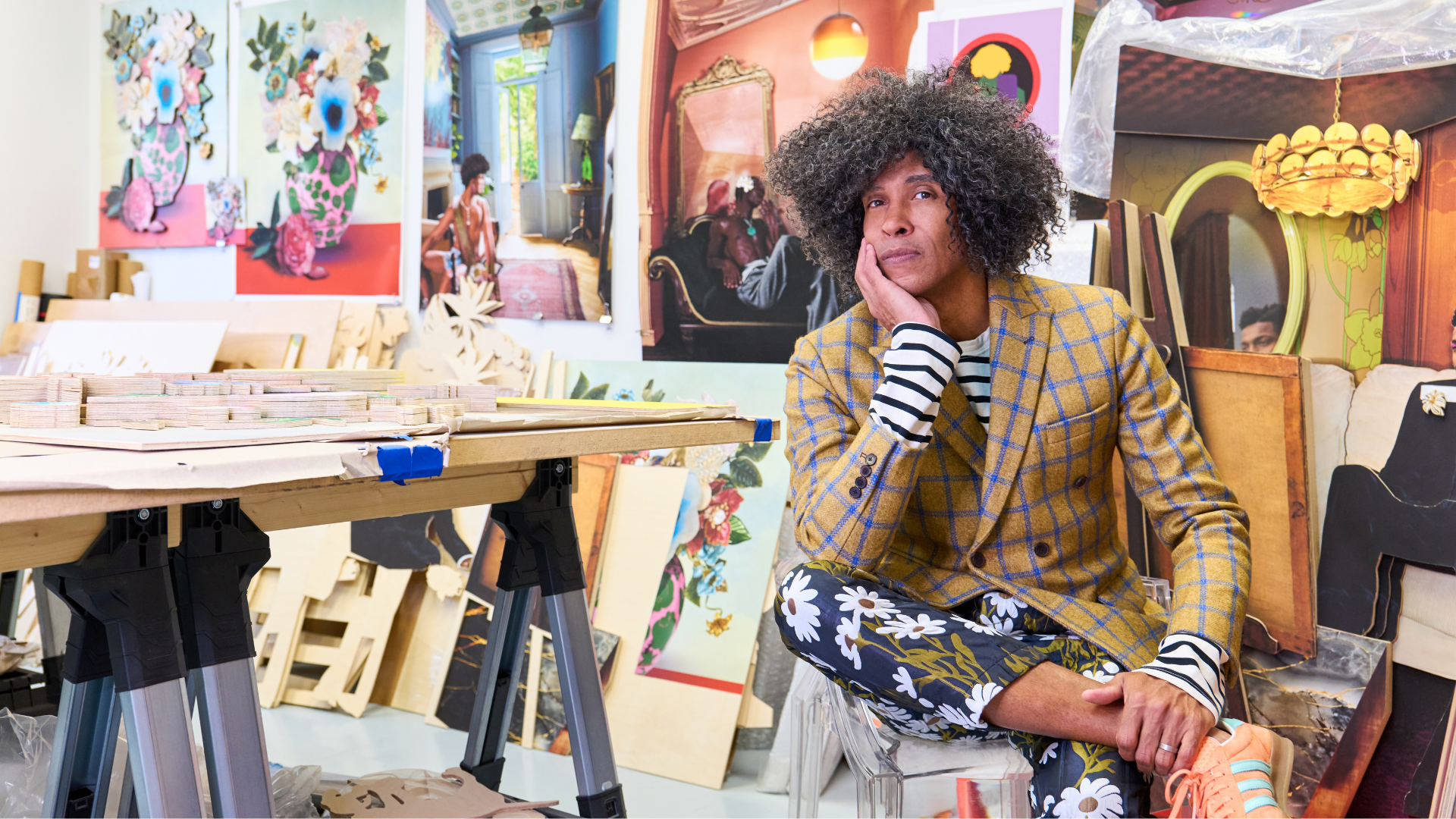
There is no nonsense in Ron Norsworthy’s gaze or tone. This is something I noticed immediately during our interview. The interdisciplinary artist has eyes similar to an owl’s, black, wide, and sparkling with clarity. With the same emphasis as a grand reverend, Norsworthy tilts his head, corkscrew curls bouncing, and declares that each of us who walk this earth is “f—— beautiful.” Amidst this era we are living in so thick with psychic distortions, plasticized aesthetics, and skewed self-images, his words, weighted and sermonic, feel especially energizing. More than once I suppress my desire to stand up and shout, “Amen!” Ready to release one of those long and loose churchy “mm-hmms.”
We’re seated inside the Edwynn Houk Gallery on Fifth Avenue, curled up in sumptuous chairs that surround Norsworthy’s forthcoming exhibition, I, Narcissus. He’s dressed simply in an olive-green motorcycle jacket, pencil-thin jeans, and a dove-gray turtleneck, sitting with the same authority as his regal subjects. Revising the tragic Greek myth, I, Narcissus aims to subvert not only the exclusionary cabals of beauty and history but also to hold up a mirror to a people perpetually erased. However frivolous a word like beauty may sound, beauty, as a system, is often an insidious concept.
“Who gets to be beautiful? Who are the arbiters of beauty?” These are questions that Norsworthy asks and explores through his exhibition. “Who does culture back, allow, and support? We can’t think about beauty without thinking about gender, class, or ethnicity, all of which are narratives that have been shaped for us. They’re constructions and often the classical notion of beauty has been shaped by white models of power. I wanted to reanimate those narratives and make them more relevant to people like me,” Norsworthy says at one point during our conversation.
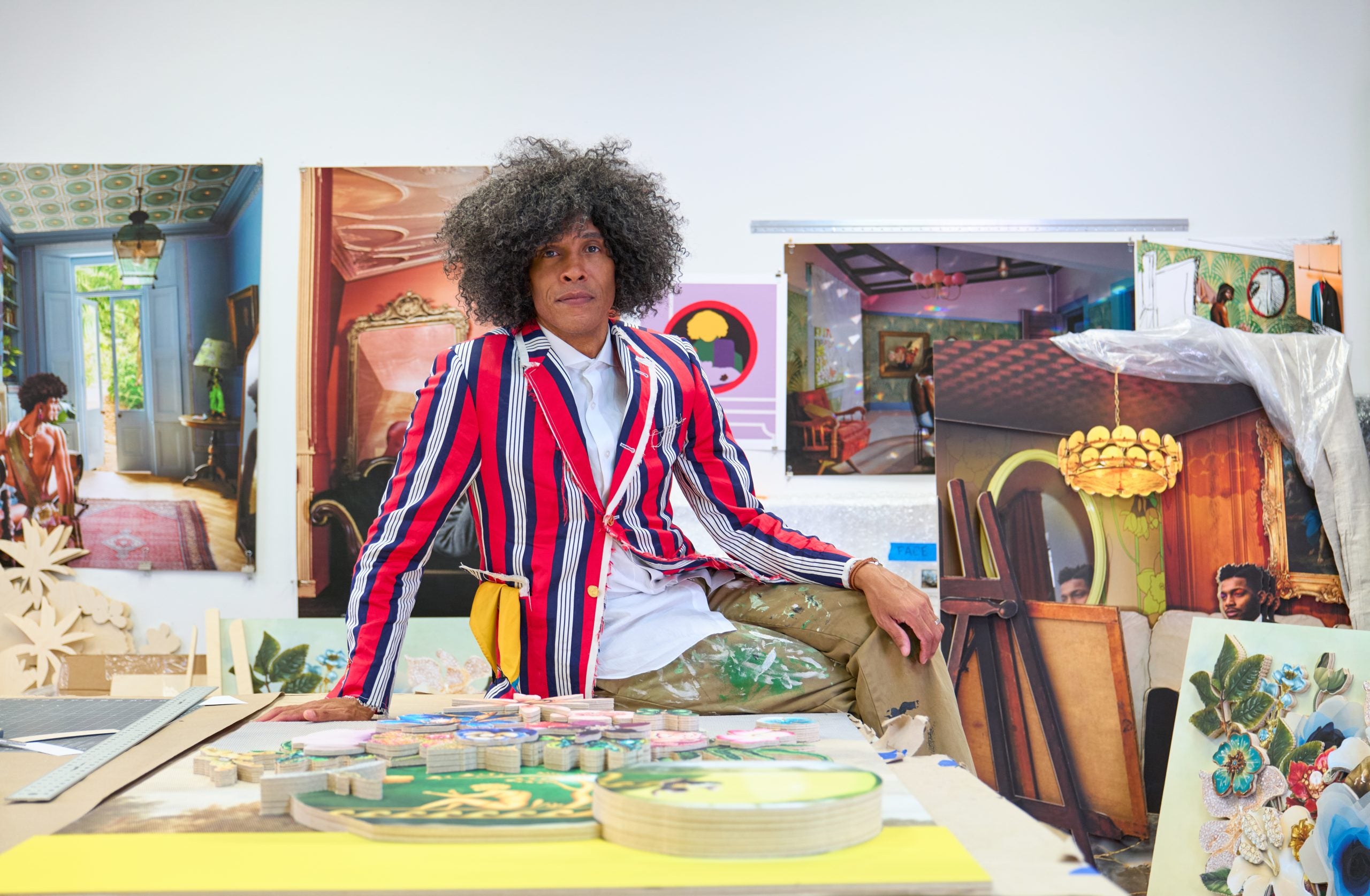
Born and raised in South Bend, Indiana, Norsworthy’s journey to becoming an influential figure in the art world was shaped by the women of his family. He tells me a story of his grandmother’s jewelry box, its light, each set, and all her pendants. “I remember her sewing, the two of us looking at Vogue illustrations, and then I’d run off to try to sketch those dresses,” he said. His mother was another figure he grew up admiring. He recalls how she would tie her scarves sensually. Here he mentions what he calls an “incredible fur coat” of hers that he loved tremendously. “I know too many beautiful Black women who just knew how to carry themselves—it was never the physical markers, it was just how they radiated the whole package.”
These impressions shaped by Black women have left an indelible mark on his style edicts. Like his grandmother, he refuses to conflate fashion as style, preferring high-quality foundational pieces to cheap and poorly-produced fabrics. “Fashion is a moment,” Norsworthy declares. “Style is eternal and I’ve never been interested in that kind of impermanence.” Right now, he’s having a “bespoke moment,” designing and embroidering his suits and jackets. Designers like Emily Adams Bode Aujla and Thom Browne, whom he applauds for their level of tailoring, are also favorites. Similar to his artworks, Norsworthy’s style is not only a way to honor the depth of one’s inner life but also an active way to empower our change.
“I grew up in a time where there were so many limitations put on me. There was this kind of eternal unrest because I knew I could never meet them,” Norsworthy recalls. He relays stories of his upbringing that made it harder to build out a world that he felt comfortable living in, or one that made sense. “I think it’s so important to be able to look in the mirror and say, ‘I’m not ashamed of who I am,’ and for each of us to live robustly in our identities.”
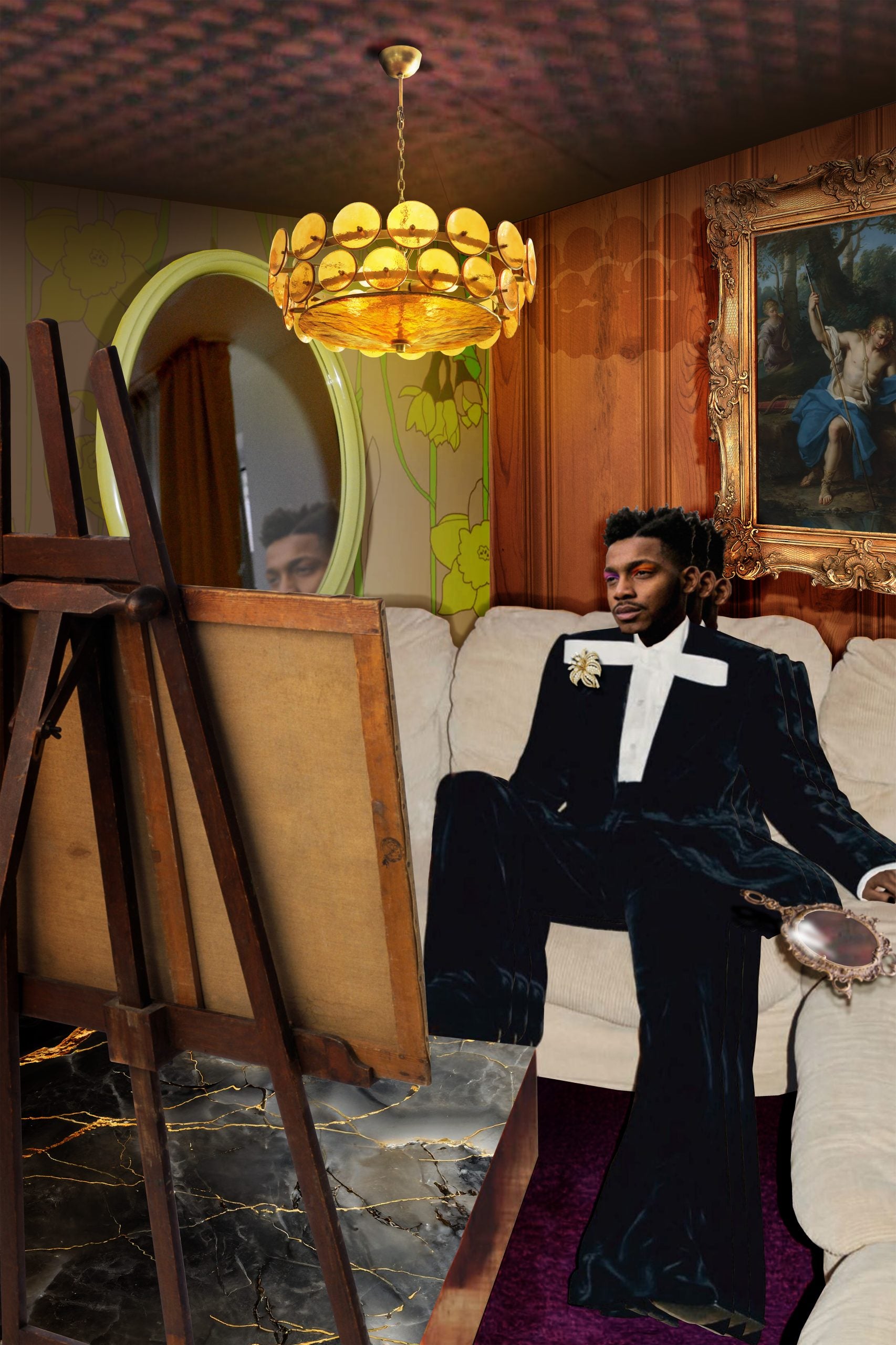
Norsworthy’s career began in the realm of production design, where he crafted visually stunning sets or “site-specific installations” for artists like Britney Spears, Lisa Marie Presley, the Notorious B.I.G. and so many more. The visionary behind moments like “Bag Lady” by Erykah Badu or Foxy Brown’s “I’ll Be,” he’s worked alongside luminaries like costume designer June Ambrose and director Hype Williams. Missy Elliott’s “The Rain (Supa Dupa Fly)” is another feat he is extremely proud to have brought to fruition. “Production design and creative direction was my first canvas,” he admits. “It was a way for me to express myself and to challenge the limits of our dreams.”
For nearly three decades, his designs, characterized by their baroque mise-en-scenes and ornamented realities have made him one of the world’s most sought-after names in the industry. But Norsworthy’s ambitions always extended beyond the world of production design. “I’ve never wanted to be confined to one medium,” he explains. Art, he affirms is about exploration and experimentation–a way to push through boundaries.
He soon began exploring other forms of artistic expression, from photography to installation. After starting a home brand, he became one of the first Black men to offer sold-out collections. “I have a very broad practice. I’m not afraid of materials.” He says he loves sculptures, collages, and assemblages. Here Norsworthy mentions that he is also skilled at creating beyond his expectations. “If I decide I want to design sneakers or a wedding gown, I could and would do it with my same methodology.”
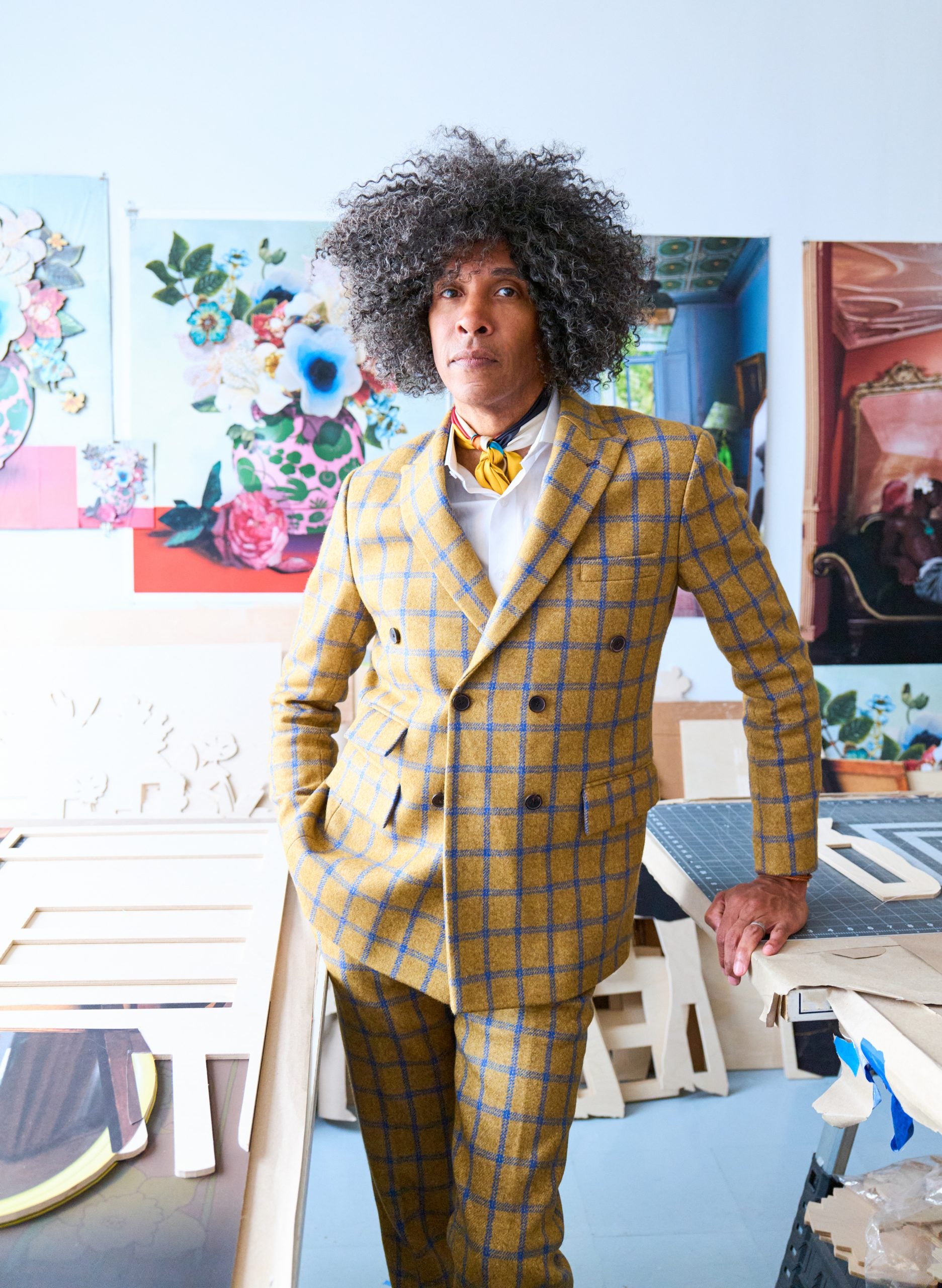
Across eleven offerings, a swirl of photographs mined from the internet and transferred onto wood panels, Norsworthy offers the kind of narratives most movies refuse to consider, let alone imagine. Instead of Black life maimed, denuded of dignity, and degraded, each portrait that makes up I, Narcissus is a study of delicious glamour. Within Norsworthy’s universe, Black men are seen gazing at their reflections inside cozy, warmly lit homes or wearing tailored suits adorned with cabochon-and-diamond flower brooches.
In one portrait named, “Narcissus in a Fleetwood Chapel” a Renaissance figure reminiscent of the iconic artist Prince wears a petulant expression and a lavish coat, lounging tenderly in a Cadillac Coupe DeVille. Though Norsworthy insists that all are his favorites, it’s this one that continues to electrify.” He’s challenging what we understand gender to be. He’s got pantyhose on, no top, no shirt, a fur coat, and the hair is curled. I love all these elements, combined with his pose and reflection.”
In another curious assemblage, a man dressed to the nines contemplates the gorgeous beauty of a Laura Wheeler Waring portrait. In others, vases, roses, and tulips are beset with glittering diamond parures one might find at a Sotheby’s auction.
My favorite from the exhibition is called Narcissus (Maybe It’s Time.) A young man seems to stare through the frame. His skin, a greedy shade of brown, seems to eat up all the light. He’s slouched, half-way dressed, tulips dressing his thighs. His hair is drizzled in Soul Glo that would ruin a couch. Circling his collarbones and chest, a pearl and diamond necklace clings to his skin. A suit hangs against the wall. A suitcase and a pair of women’s shoes rest at his feet. The room he’s in is bare in its luxuries: a stool, an old-school mirror, a still-life portrait, and an unopened parcel draped on a pink chair. Refracted rainbows dance against the wallpaper and floor. But it’s the man’s face which intrigues me most.
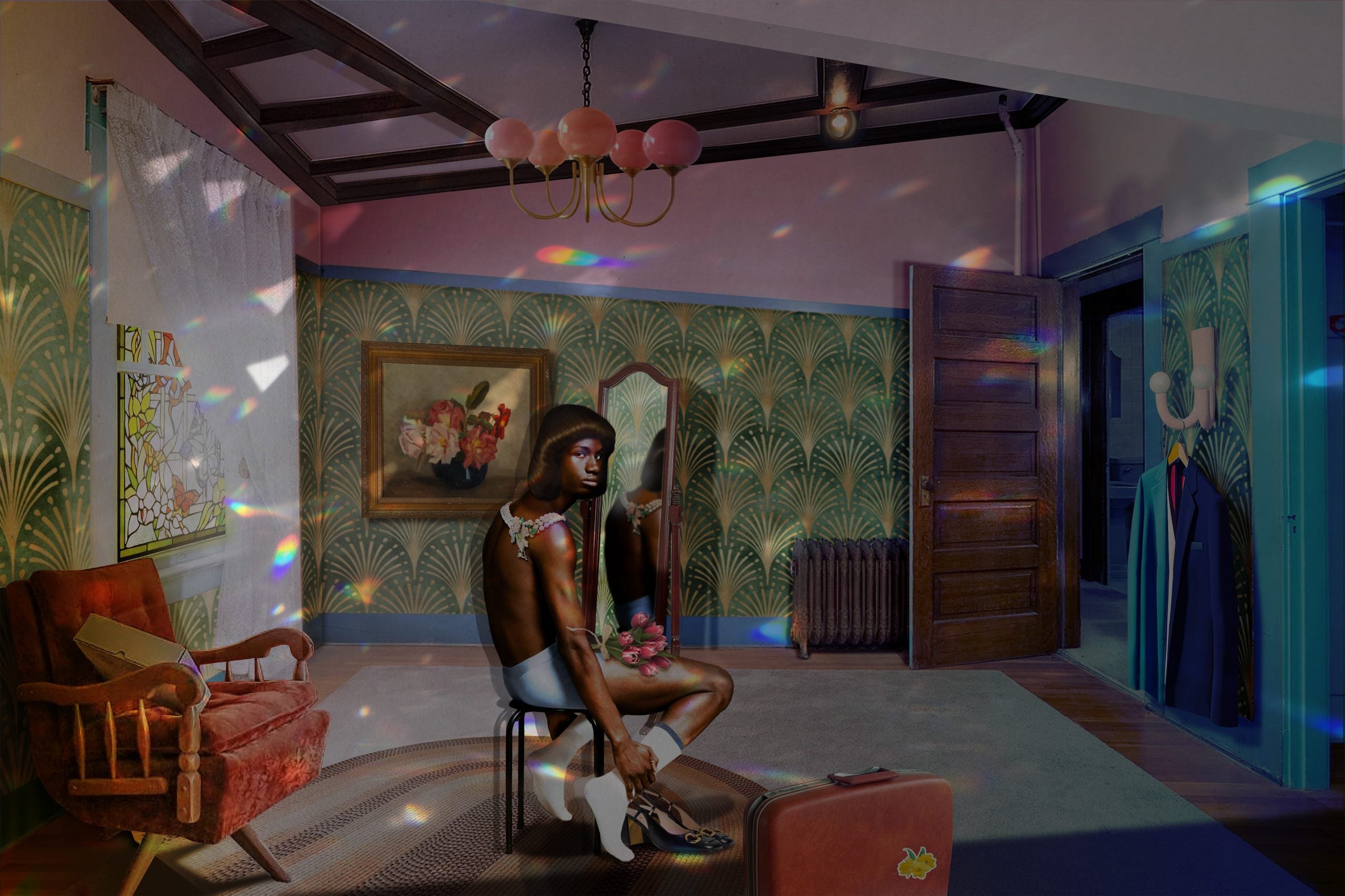
His lips are set, his eyes confrontational almost, though his posture seems delicate, tender, shoulders hunched. Is he upset? Is this an invasion of his privacy? Is he sad? Has he lost a friend? Am I studying him too much? Wanting deeply for him to imbue what I imagine? Is that simply just his face? Or maybe he’s bored, bored of being elegant, bored of being perceived at all, bored of the world’s ridiculous binaries.
Of all my habits, the one most crucial for my survival has been my awareness that there is no diamond as bright as me. I grew up in a household thick with a haughty mother’s love. A love that insisted that I think highly of myself, that I hold my head high, that I value my feelings, and that I spend hours honoring myself in the mirror.
There were, of course, a few years where I mistook self-confidence for self-love, and two years where I lost my wind to the weight of the world. But even so, my mother’s love for me outpaced all modes of hate. I wish everyone knew the feeling of being self-possessed. I wish everyone knew how to remain serene in a world that bets and banks on us destroying self-concepts. One of the most dizzying effects of commodifying beauty is how subtle it is, how normalized. Such a concept offers only a refracted mirror, one which will put you at war with yourself and eat up your imagination.
These ideals point to why Norsworthy’s works offer a potent and urgent question. What would the world be like if we softened our minds and dared to love our reflections? His latest exhibit I, Narcissus aims to answer this in a unique manner.
Ron Norsworthy’s I, Narcissus opens at the Edwynn Houk Gallery on November 14 at 745 5th Avenue.





